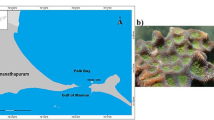Abstract
A Gram-negative, strictly aerobic, non-motile, rod-shaped and psychrophilic bacterial strain, PAMC 27137T, was isolated from the marine sediment of the Ross Sea, Antarctica. Strain PAMC 27137T was observed to grow at 4–10 °C, at pH 6.5–7.5 and in the presence of 2.5–4.0 % (w/v) sea salts. Phylogenetic analysis based on the 16S rRNA gene sequence indicated that strain PAMC 27137T belongs to the genus Lacinutrix showing the high similarities with Lacinutrix mariniflava JCM 13824T (97.6 %) and Lacinutrix algicola JCM 13825T (97.1 %). Genomic relatedness analyses based on the average nucleotide identity and the genome-to-genome distance showed that strain PAMC 27137T is clearly distinguished from the most closely related Lacinutrix species. The major fatty acids (>5 %) were identified as iso-C15:1 G (19.9 %), iso-C15:0 (19.3 %), iso-C17:0 3-OH (11.3 %), summed feature 9 (C16:0 10-methyl and/or iso-C17:1 ω9c as defined by MIDI, 9.1 %), iso-C15:0 3-OH (7.5 %), and anteiso-C15:1 A (5.8 %). The polar lipids were found to consist of phosphatidylethanolamine, an unidentified aminolipid, an unidentified aminophospholipid, and five unidentified phospholipids. The major respiratory quinone was identified as MK-6. The genomic DNA G+C content was determined to be 32.1 mol%. Based on the data from this polyphasic taxonomic study, strain PAMC 27137T is considered to represent a novel species of the genus Lacinutrix, for which the name Lacinutrix jangbogonensis sp. nov. is proposed. The type strain is PAMC 27137T (=KCTC 32573T=JCM 19883T).

Similar content being viewed by others
References
Auch AF, von Jan M, Klenk HP, Göker M (2010) Digital DNA–DNA hybridization for microbial species delineation by means of genome-to-genome sequence comparison. Stand Genomic Sci 2:117–134
Bernardet J-F, Nakagawa Y, Holmes B (2002) Proposed minimal standards for describing new taxa of the family Flavobacteriaceae and emended description of the family. Int J Syst Evol Microbiol 52:1049–1070
Bowman JP, Nichols DS (2005) Novel members of the family Flavobacteriaceae from Antarctic maritime habitats including Subsaximicrobium wynnwilliamsii gen. nov., sp. nov., Subsaximicrobium saxinquilinus sp. nov., Subsaxibacter broadyi gen. nov., sp. nov., Lacinutrix copepodicola gen. nov., sp. nov., and novel species of the genera Bizionia, Gelidibacter and Gillisia. Int J Syst Evol Microbiol 55:1471–1486
Chun J, Lee J-H, Jung Y, Kim M, Kim S, Kim BK, Lim Y-W (2007) EzTaxon: a web-based tool for the identification of prokaryotes based on 16S ribosomal RNA gene sequences. Int J Syst Evol Microbiol 57:259–2261
Collins MD, Jones D (1981) Distribution of isoprenoid quinone structural types in bacteria and their taxonomic implication. Microbiol Rev 45:316–354
Felsenstein J (1993) PHYLIP: phylogenetic inference package, version 3.5c. Seattle, USA
Fitch WM (1971) Toward defining the course of evolution: minimum change for a specific tree topology. Syst Zool 20:406–416
Gordon RE, Barnett DA, Handerhan JE, Pang CH-N (1974) Nocardia coeliaca, Nocardia autotrophica, and the Nocardin strain. Int J Syst Evol Microbiol 24:54–63
Goris J, Konstantinidis KT, Klappenbach JA, Coenye T, Vandamme P, Tiedje JM (2007) DNA–DNA hybridization values and their relationship to whole-genome sequence similarities. Int J Syst Evol Microbiol 57:81–91
Guindon S, Gascuel O (2003) A simple, fast, and accurate algorithm to estimate large phylogenies by maximum likelihood. Syst Biol 52:696–704
Lane DJ (1991) 16S/23S rRNA sequencing. Nucleic acid techniques in bacterial systematics. Wiley, New York, pp 115–175
Lee Y, Kim G, Jung Y-J, Choe C-D, Yim J, Lee H, Hong S (2012) Polar and alpine microbial collection (PAMC): a culture collection dedicated to polar and alpine microorganisms. Polar Biol 35:1433–1438
Minnikin DE, O’Donnell AG, Goodfellow M, Alderson G, Athalye M, Schaal A, Parlett JH (1984) An integrated procedure for the extraction of bacterial isoprenoid quinones and polar lipids. J Microbiol Methods 2:233–241
Nedashkovskaya OI, Kwon KK, Yang S-H, Lee H-S, Chung KH, Kim S-J (2008) Lacinutrix algicola sp. nov. and Lacinutrix mariniflava sp. nov., two novel marine alga-associated bacteria and emended description of the genus Lacinutrix. Int J Syst Evol Microbiol 58:2694–2698
Richter M, Rosselló-Móra R (2009) Shifting the genomic gold standard for the prokaryotic species definition. Proc Natl Acad Sci USA 106:19126–19131
Rosselló-Mora R, Amann R (2001) The species concept for prokaryotes. FEMS Microbiol Rev 25:39–67
Saitou N, Nei M (1987) The neighbor-joining method: a new method for reconstructing phylogenetic trees. Mol Biol Evol 4:406–425
Sasser M (1990) Identification of bacteria by gas chromatography of cellular fatty acids. USFCC News Lett 20:16
Smibert RM, Krieg NR (1994) General characterization. In: Gebhardt P, Murray RGE, Wood WA, Krieg NR (eds) Methods for general and molecular bacteriology. American Society for Microbiology, Washington, DC, pp 607–654
Srinivas TNR, Prasad S, Manasa P, Sailaja B, Begum Z, Shivaji S (2013) Lacinutrix himadriensis sp. nov., a psychrophilic bacterium isolated from a marine sediment, and emended description of the genus Lacinutrix. Int J Syst Evol Microbiol 63:729–734
Swofford DL (2002) PAUP*, phylogenetic analysis using parsimony (* and other methods), version 4. Sinauer Associates, Sunderland
Tamaoka J, Komagata K (1984) Determination of DNA base composition by reversed-phase high performance liquid chromatography. FEMS Microbiol Lett 25:125–128
Yi H, Cho J-C, Chun J (2012) Flavivirga jejuensis gen. nov., sp. nov., and Flavivirga amylovorans sp. nov., new members of the family Flavobacteriaceae isolated from seawater, and emended descriptions of the genera Psychroserpens and Lacinutrix. Int J Syst Evol Microbiol 62:1061–1068
Zhou M-Y, Wang G-L, Li D, Zhao D-L, Qin Q-L, Chen X-L, Chen B, Zhou B-C, Zhang X-Y, Zhang Y-Z (2013) Diversity of both the cultivable protease-producing bacteria and bacterial extracellular proteases in the coastal sediments of King George Island, Antarctica. PLoS ONE 8:e79668
Acknowledgments
We thank the crew of the R/V ARAON support at sea. This work was supported by Korea Polar Research Institute (Grant PM11030 and PE14080).
Author information
Authors and Affiliations
Corresponding author
Electronic supplementary material
Below is the link to the electronic supplementary material.
Rights and permissions
About this article
Cite this article
Lee, Y.M., Hwang, C.Y., Lee, I. et al. Lacinutrix jangbogonensis sp. nov., a psychrophilic bacterium isolated from Antarctic marine sediment and emended description of the genus Lacinutrix . Antonie van Leeuwenhoek 106, 527–533 (2014). https://doi.org/10.1007/s10482-014-0221-5
Received:
Accepted:
Published:
Issue Date:
DOI: https://doi.org/10.1007/s10482-014-0221-5




